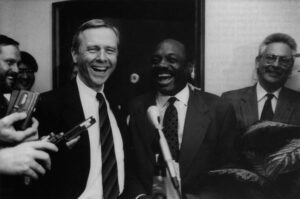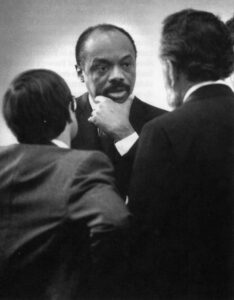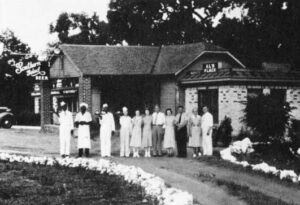Jim Richardson
- 1993

Fellowship Title:
- California's Willie Brown
Fellowship Year:
- 1993

Willie Brown: Power, Money and Instinct
SACRAMENTO, CALIFORNIA–Frank Fat’s is the smallest building on its block. Painted garishly pink outside, the Chinese restaurant is sandwiched between a parking garage and an old brick office building a short walk from the California State Capitol. The napkin from Frank Fat’s restaurant that resulted in major changes to California’s civil liability laws. “DMZ” at the top stop for De-Militarized Zone. The handwriting is state Senator Bill Lockyer’s, then chairman of the Senate Judiciary Committee. (Courtesy of Tom Dressler, Los Angeles Daily Journal) Inside, behind the restaurant’s heavy oak door, is a long, narrow bar. Fat’s was remodeled in the mid-1980s to give it a fashionably slick Art Deco look. Most of the tables are in the rear. But off to one corner is a booth with a brass plaque memorializing it as the favorite table of James “Judge” Garabaldi, who until his death in 1993, was the king of Sacramento lobbyists. He represented a most lucrative set of clients: The liquor and horse racing industries. The best dish in this Chinese restaurant is the

Willie Brown: The Members’ Speaker
SAN FRANCISCO — Willie Brown, his tuxedo glistening in the spotlight, bounced onto a stage in the ornate ballroom of the Fairmont Hotel, the grandiose citadel of San Francisco’s old-moneyed establishment. California’s most powerful politician began introducing his after-dinner entertainment and his guests definitely would not be disappointed. On Brown’s cue, Ray Charles took stage, backed by the Oakland Symphony Orchestra. Willie Brown hams it up with his special guest, entertainer Ray Charles, at a San Francisco fund-raiser for Brown’s Political treasury in April 1993. Lobbyists, corporate executives and others paid $10,000 a table for the evening. (Photo by Louis Bernstein) Sitting at Table No. 55 that April evening was the mayor of San Francisco, Frank Jordan. Nearby, Brown’s night-life buddy, Herb Caen, the San Francisco Chronicle columnist, celebrated his 77th birthday over a cake given to him by Brown. Over at Table No. 84 was Marguerite Archie-Hudson, a former Brown aide and now a Democratic state legislator from Los Angeles. Assemblyman John Burton, the crusty chairman of the powerful Rules Committee, was introduced by

Willie Brown: The Play for Power
SACRAMENTO, CALIFORNIA — Willie Brown arrived to face the cameras and the questions. A new Speaker had been chosen in a closed-door meeting of Democrats in the California State Assembly and it was time to make the announcement: A liberal Democrat from San Francisco had emerged the winner. It was not Willie Brown. Young Assemblyman Willie Brown in his Sacramento state Capitol office in 1967. (Photo courtesy California State Library.) The new Speaker in June 1974 was Leo T. McCarthy, a polished, somewhat stiff, New Zealand-born lawyer representing a San Francisco district neighboring Brown’s. In California, only the governor is more powerful than the Speaker and it was a position Brown wanted dearly. Brown and the retiring Speaker, Bob Moretti, stood with McCarthy in a show of Democratic solidarity. But it was difficult. It was hard enough that Brown had lost, that he had failed to become the first African-American Speaker in California history. Harder still, four of the six blacks in the Assembly went against Brown and he fell short of victory by exactly

Willie Brown: The Early Years
Dallas, Texas-On a drizzly January morning earlier this year, a crowd of politicians and lobbyists from California jammed into the Good Street Baptist Church, a modest brick building in the heart of Dallas’s black neighborhood. The power elite of the nation’s most populous state had come to pay homage to Minnie Collins Boyd, a small black woman who had worked much of her life as a maid for Dallas’s white families. She had died at the age of 83. They listened as tributes were read from Texas Governor Ann Richards and former President Ronald Reagan. Back in California a night earlier, Governor Pete Wilson paid his respects during his televised annual “state of the state” address. Willie Brown, Speaker of the California State Assembly, and a Democrat from San Francisco. (Photo by Lois Bernstein.) Minnie-as she was universally called by her friends, family and the former president was the mother of Willie Lewis Brown, Jr., who at that moment was arguably the most powerful politician in California and by virtue of that status, arguably the
